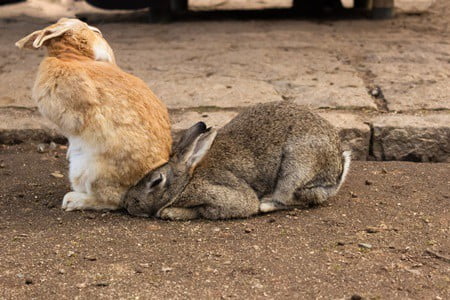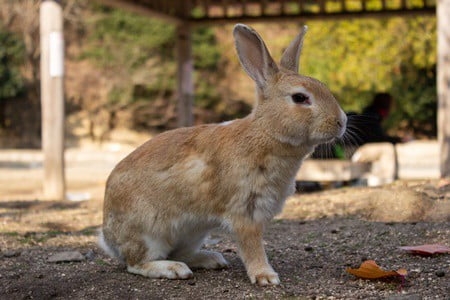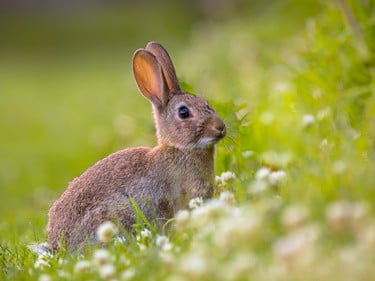Until 1912, rabbits and hares were classified in the order Rodentia. They’re now moved in a new order called Lagomorpha, which also includes pikas. Rabbits are native to Europe, North America and parts of South America, Africa, and Central and Southern Asia.
Rabbits have been relatively unchanged in the last 40 million years. After entering North America during that time, rabbits underwent most of their changes there. Much of the rabbit’s evolutionary history revolves around its domestication, resistance to pathogens, and the changes it experienced from human and environmental impacts.
Research suggests that rabbit domestication occurred over thousands of years. Today, we have more than 50 domestic rabbits that were selectively bred from one species. They’ve been tamed from small changes in many of their genes, which makes them easy to raise in captivity and as lab animals.
Rabbit Ancestor Evolution
Rabbits belong to the order Lagomorpha, along with pikas. Rabbits are distinguished from rodents because the former has two sets of incisor teeth with one set behind the other. Rodents lack the two extra incisors, and are thus placed in a different order, Rodentia.
Although they were grouped together under one class, they were later isolated because scientists found their similarities resulted from convergent evolution. However, DNA analysis shows that rabbits and rodents do share a common lineage, thus grouping them in the superorder, Glires.
Evolutionary Tree and Classification
Rabbits and hares belong to the family Leporidae, which hasn’t been changed much since the Eocene Epoch (roughly 40 million years ago).
During this time, rabbits had entered North America, undergoing most of their changes there. By the Miocene Epoch (about 7 million years ago), rabbits and hares reestablished in Asia and moved to Europe, thus explaining their current distribution.
They’re different from pikas (Ochotonidae) mainly due to their morphology. Rabbits and hares have a more arched skull and a relatively upright head posture, associated with their ability to hop. The elongation of their limbs and strengthened pelvic girdle and hind limbs also makes them separate from Ochotonidae.
Domestication of Rabbits
Both domestic and wild rabbits are economically important to humans. Wild rabbits are used for hunting, as well as for their meat and fur. Domestic rabbits are raised for their skins and meat.
There are more than 50 strains of domestic rabbits today. They have been selectively bred to be physically attractive, to produce maximum meat, and to be easily raised in captivity. Domestic rabbits are popular in the pet trade, and in laboratory use for medical and scientific researches.

Origins of Domestication
Archaeological and fossil records indicate that wild rabbits were hunted for their fur and meat from between 2.6 million to 11,700 years ago (the Pleistocene Epoch).
Roman literature from the 1st century BCE shows the oldest historical record of rabbits being raised as livestock.
By the 14th century BCE, fossil records also indicate that rabbits were transported in shops to many islands in the Mediterranean. By the 3rd century BCE, rabbits were sent to Malta and the eastern Mediterranean islands by the Middle Ages.
According to Trends in Ecology and Evolution, a comparison of the genomes of wild rabbits and domesticated European rabbits shows that both groups became isolated from one another between 17,700 and 12,200 years ago.
This could be due to the pulling away of continental mountain glaciers and ice sheets in Southwestern Europe. Records indicate that domestication probably took place between the ice sheets retreating and 1st century BCE in this region.
Studies show that rabbit domestication took place over hundreds, or even thousands of years as it relied on human and natural-driven factors, not just a single event.
Rabbit Adaptations
| Enhanced sense of smell | Social and reproductive communication |
| Ears | Detecting predators and thermoregulation |
| Double digestion | Optimum use of short food supply |
| Copulation-induced ovulation | Efficient reproduction, more offspring |
| Postpartum estrus | More offspring |
| Nutrient-dense milk | Rapid weaning with minimum attention to offspring |
| Eating animal meat | To meet protein requirements |
| Resistance to pathogens | Fightback against myxomatosis |
The evolutionary process of natural selection has allowed rabbits to go through numerous physical adaptations. These adaptations are affected by natural, environmental and human factors, and allow rabbits to thrive.
Sense of Smell
One may feel that hearing is an important mode of communication in mammals. However, in rabbits, their sense of smell plays a more important role in this department.
Rabbits have well-established glands throughout their body. They rub these glands on objects to send messages of sex, age, group identity, ownership of territory, as well as social and reproductive status.
Urine is another important chemical communication tool.
Ears
Rabbits have prominent ears that can measure up to 6 cm long. In addition to detecting predators, the long ears of a rabbit serve many other survival functions.
The ears also help to cool down a rabbit’s body. According to the Journal of Ecology, European wild rabbits that were introduced to different climates in Australia showed many physical adaptations in response to ambient temperature. Natural selection caused them to go through genetic changes.
Rabbits in warmer regions grew longer ears and a leaner body core. The external part of the ear, also called the pinnae, has thermoregulatory functions.
According to the Asian Journal of Poultry Science, rabbits rely on the dilation of the blood vessels near their ears for thermoregulation. The ears radiate heat and allow rabbits to adjust their core temperature to prevent overheating in high ambient temperatures.
Digestion
Rabbits have large digestive tracts that allow them to consume large quantities of plant material and keep up with their nutrient demands.
A rabbit’s diet predominantly consists of grasses, herbs, and twigs – all of which contain massive amounts of hard-to-digest cellulose.
Rabbits are able to digest cellulose by passing two types of feces: soft, malodorous pellets that resemble a bunch of grapes (called cecotropes), and hard droppings (called fecal pellets).
Anything that a rabbit eats eventually comes together in the cecum of a rabbit’s digestive tract. The cecum is a secondary chamber situated between the small and large intestine. It contains a plethora of symbiotic bacteria that facilitate cellulose digestion and produce B-vitamins.
Cecotrophes are formed in the cecum and contain 5 times more vitamins than hard feces. As they are being passed out of the anus, they are immediately eaten by the rabbit. The cecotrophes are then re-digested in the stomach, allowing rabbits to utilize any nutrients that may have been missed during the first digestion.
Double-digestion is an adaptation that allows rabbits to thrive in conditions when food is scarce. Because rabbits don’t hibernate in the winter, this lets them survive on twigs and bark and other low-nutrient foods.
Reproduction
Rabbits are known for their ability to produce many offspring (kittens). However, lack of resources and unfavorable weather conditions can suppress a rabbit’s potential to reproduce.
To overcome this, rabbits rely on a combination of factors to keep up with their reproductive reputation.
Rabbits can breed at a young age. Many rabbits conceive litters of up to seven offspring 4-5 times a year. Females are efficient with their reproductive cycle because they show induced ovulation. So, their ovaries only release eggs during breeding, instead of a regular cycle.
Rabbits also go through postpartum estrus, which allows them to conceive as soon as they give birth to a litter.
Offspring
Newborn rabbits are altricial, which means they’re helpless at birth and require care and feeding by the parents. They’re also furless and blind. However, mother rabbits are highly inattentive to their offspring and are almost absent during their growth.
A mother rabbit may nurse her young only once a day for just a few minutes. Furthermore, bucks do not aid in rearing their offspring.
Rabbits have evolved to produce highly nutritious milk to make up for the lack of attention and feeding they provide their young. In fact, rabbit milk is considered among the most nutritionally dense of all mammalian milk. This milk allows rabbits to grow quickly. Most kittens are weaned in about a month.
Myxomatosis
It has been almost 70 years since a viral disease called myxomatosis wiped out entire rabbit populations in Britain, France, and Australia.
The spread occurred in Australia when the Council for Scientific and Industrial Research conducted its first field trials of the viral disease in Wardang island. In 1950, the virus was released in Australia to control the feral rabbit population. The SLS strain of the virus was initially lethal, exhibiting a fatality rate of about 99.8%.
The virus was later replaced by less deadly strains, which enhanced disease transmission and allowed longer survival of rabbits that were infected. It caused a strong selection pressure for rabbits to gain resistance against the disease. Over time, as rabbits became more resistant to myxomatosis, the viral strains became less deadly, according to PLOS Pathogens.
In Europe, the virus was introduced by an owner of an estate in Northwestern France, Dr. Paul-Félix Armand-Delille. According to Viruses, even though his intention was to eliminate the rabbits on his property, the disease rapidly spread to Ireland, Western Europe, and the UK.
Resistance Against Myxomatosis
A study in the journal Science that looked at rabbit DNA spanning thousands of miles and 150 years shows how changes in the rabbit genome helped overcome this deadly virus.
The study shows that resistance to myxomatosis in rabbits developed via small changes spread across the rabbit genome, instead of large changes in a few genes.
These gene mutations increased in frequency in Australia, Britain and France independently. This indicates that the evolution of rabbit resistance to the Myxoma virus revolved around these genes.
The Carnivorous Rabbit
Contrary to popular belief, not all rabbits are obligate herbivores. In fact, Northwestern Naturalist has found hares that feed on carcasses.
This allows rabbits to complement their plant-based diet with animal-based protein. Such rabbits may feed on meat from their own kind or even of their predators, such as the lynx.
Researchers from this study realized this by accident. They placed hare carcasses at several regions in Yukon, Canada with remote cameras next to them. Instead of larger predators, such as wolves, scientists noticed a show of cannibalism by hares that consumed their own kind.

Surprisingly, one of the cases was also of a hare eating the carcass of its prime predator, the Canada lynx.
In another situation, a hare was seen repeatedly devouring feathers from a Spruce Grouse carcass. The consumption of feathers is highly unusual even among carnivorous animals. This is because feathers are mostly made up of keratin, which contains very little protein.
Furthermore, little is known on how a rabbit’s stomach can even break down feathers to obtain nutrients from it. Scientists believe feathers may be a source of fiber for rabbits.
Why Do Some Rabbits Eat Animal Meat?
It is believed that hares that eat animal meat do this to elevate their own protein intake during the harsh Canadian winters. During such conditions, nutrients are in short supply and any protein is a luxury.
It was also discovered that these hares were territorial with their meals, keeping them safe from other scavengers. However, the rabbits stuck with small to medium carcasses, instead of larger carcasses such as reindeer because of competition from large predators.
Consumption of carrion is being spotted more frequently among animals that were once believed to be true herbivores. This is particularly the case in cold areas, where animals have to survive on a protein and nutrient-deficient diet. Therefore, it’s hard to say no to a rare protein offering, even if it comes in the form of animal meat.
The evolution of rabbits is likely to be largely influenced by humans. Because rabbits haven’t been domesticated for as long as cattle, sheep, and dogs, they’re the perfect test subject to understand the changes brought about by domestication.
Although scientists aren’t able to pin down the effects of domestication on a single gene, they have found that the greatest adaptation between wild and domesticated rabbits was of the brain. This indicates that the most important changes during rabbit domestication likely involved behavioral traits that allowed them to tolerate humans and their environment.

